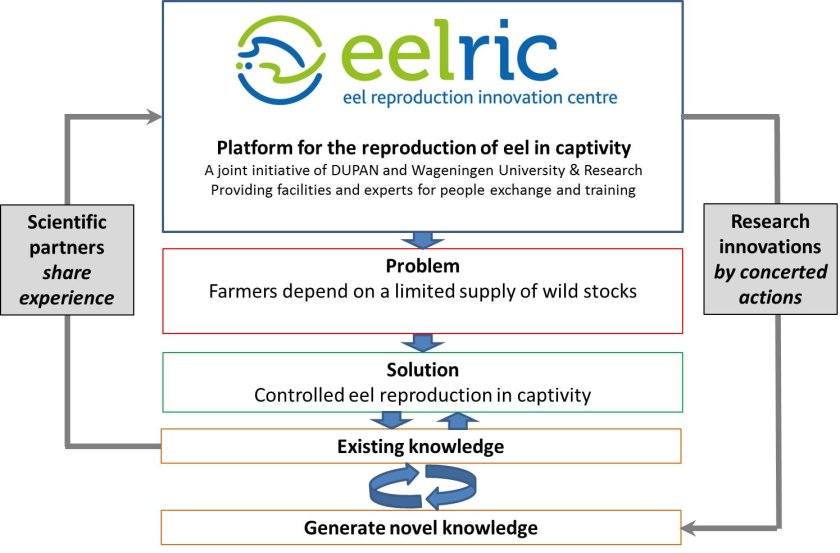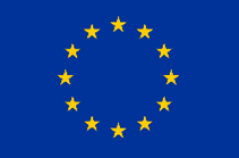
Project
EELRIC: Eel Reproduction Innovation Centre
EELRIC is a platform for the reproduction of eel and a home for an international consortium of partners sharing experience and collaborating to force breakthroughs.
World-wide, eel populations have decreased strongly in numbers since the 1970s. The existing eel farms still depend on the catches of glass eels in nature which are then raised to market size. Only a restricted number of glass eels is available for aquaculture and societal concern exists about the lack of sustainability. Successful propagation could supply aquaculture with glass eels and close the production cycle. This way, both eel aquaculture as well as management of the natural populations could become sustainable.
Required knowledge
Current research initiatives are either of national or commercial nature. This creates a spotty distribution of independent activities by small research groups with large overlap. With still the large gap to commercial production, a high urgency exists to share experience (expertise, tools and people) to close this gap. Both on European level with groups working on the reproduction of European eel, but also internationally with the incorporation of Japanese research groups in particular. The former EU projects EELREP and PROEEL have proved the added value of combining forces. These collaborative projects, sharing background knowledge and providing valuable foreground knowledge, have defined proof of concept for this approach to work.
The aim of Eel Reproduction Innovation Centre EELRIC is to function as a platform for the reproduction of eel and as a home for an international consortium of partners sharing experience and collaborating to force breakthroughs. The launch represents an essential step towards reproduction of eel in captivity to support sustainable aquaculture.
Initiators
EELRIC is initiated and owned by the partnership between Stichting Duurzame Palingsector Nederland (DUPAN) and Wageningen University & Research.
International consortium
On October 20, 2016, a symposium was organized with the title ‘Towards reproduction of eel in captivity to support sustainable aquaculture’ at the campus of Wageningen University & Research in The Netherlands. Participants presented their recent research on this topic. Under ‘downloads’ the abstract book of the symposium. The symposium was part of a workshop and prelude to a meeting to shape and establish international collaboration within the Eel Reproduction Innovation Centre (EELRIC). Its objectives were discussed and it was explored how such international collaboration could be established.
Participants were eager to collaborate and to join the international EELRIC consortium. Terms of reference were defined:
- Scientific collaboration is required in overcoming bottlenecks, such as first larval feeding, rapidly.
- EELRIC can serve as home for an international consortium of science and industry partners.
- The collaborative integration of background and foreground knowledge should not be a problem. EELRIC collaboration has an open character but protection of background knowledge, not foreground knowledge, could be arranged in confidentiality agreements.
- We can collaborate by the exchange of scientists (early stage and staff), materials and protocols.
- Every year there should be an EELRIC workshop.
- We as EELRIC consortium should lobby for funding collaborative opportunities on eel reproduction.
Members
Stichting Duurzame Palingsector Nederland (DUPAN)
Contact person: William Swinkels
Wageningen University & Research
Contact person: Arjan Palstra
Wageningen Eel Reproduction Experts BV
Contact person: Leon Heinsbroek
Future Genomics Technologies
Contact person: Ron Dirks
Polytechnic University of Valencia (ES)
Contact person: Juan F. Asturiano
Szent Istvan University (HU)
Contact person: Tamas Muller
University of Bologna (IT)
Contact person: Oliviero Mordenti
Muséum National d'Histoire Naturelle (FR)
Contact person: Sylvie Dufour
Norwegian University of Life Sciences (NO)
Contact person: Finn-Arne Weltzien
Technical University of Denmark (DK)
Contact person: Jonna Tomkiewicz
Thünen Institute of Fisheries Ecology (DE)
Contact person: Reinhold Hanel
Hokkaido University (JP)
Contact person: Shigeho Ijiri
Nihon University (JP)
Contact person: Katsumi Tsukamoto
University of Otago (NZ)
Contact person: Mark Lokman
NZ Premium Whitebait Ltd (NZ)
Contact person: Tagried Kurwie
University of Massachusetts (USA)
Contact person: Kenneth Oliveira
Projects
2015-2016 Launching the Eel Reproduction Innovation Centre (EELRIC) (SMP)
2017 Eel reproduction innovation centre (EELRIC): propagation of European eel to improve sustainable aquaculture. Period 2017 (PPS)
2018-2019 Eel reproduction innovation centre (EELRIC): propagation of European eel to improve sustainable aquaculture. Period 2018-2019 (EFMZV, ESF)
2020-2021 Eel reproduction innovation centre (EELRIC): propagation of European eel to improve sustainable aquaculture. Period 2020-2021 (EFMZV, ESF)
2022-2026 Development of reproduction technologies for the production of vital European eel larvae (PPS, ESF LARVitAAL)
Publications
2023
- Jéhannet, P., Palstra, A.P., Giménez Nebot, I., Swinkels, W., Heinsbroek, L.T.N., Komen, H. (2023) Recombinant FSH and LH treatment to induce oocyte development in vitro and in vivo in the European eel Anguilla anguilla. Fishes 8(3), 123.
2022
- Palstra, A.P., Bouwman, L.J., Jéhannet, P., Kruijt, L., Schipper, H., Blokland, M.H., Swinkels, W., Heinsbroek, L.T.N., Lokman, P.M. (2022) Steroid implants for the induction of vitellogenesis in feminized European silver eels (Anguilla anguilla L.). Frontiers in Genetics 13:969202
- Jéhannet, P., Palstra, A.P., Meijerhof, M., Schipper, H., Giménez Nebot, I., Swinkels, W., Heinsbroek, L.T.N., Dirks, R.P., Komen, H. (2022) The induction of oocyte maturation and ovulation in European eel (Anguilla anguilla): in vitro and in vivo comparison of progesterone with 17α,20β-dihydroxy-4-pregnen-3-one. 14ICBF, 28 June – 1 July 2022, Montpellier, France.
- Palstra, A.P., Jéhannet, P., Heinsbroek, L.T.N., Swinkels, W. (2022) Five years of optimizing the assisted reproduction protocol for European eel: What worked and what didn’t? In: Veerkamp, R.F. and De Haas, Y. (eds) Proceedings of 12th World Congress on Genetics Applied to Livestock Production (WCGALP) – Technical and species orientated innovations in animal breeding, and contribution of genetics to solving societal challenges. Wageningen Academic Publishers, Wageningen, the Netherlands. WCGALP, 3-8 July, Rotterdam, The Netherlands.
- Jéhannet, P., Palstra, A.P., Havinga, M., Heinsbroek, L.T.N., Swinkels, W., Komen, H. (2022) Improving the vitality of European eel larvae. Aquaculture Europe, September 27-30, Rimini, Italy.
- Palstra, A.P. (2022) Development of reproduction technologies for the production of vital European eel larvae (LARVitAL). Invited lecture, EAS Forum on European eel, Aquaculture Europe, September 27-30, Rimini, Italy.
2021
- Jéhannet, P., Palstra, A.P., Heinsbroek, L.T.N., Kruijt, L., Dirks, R.P., Swinkels, W., Komen, H. (2021) What goes wrong during early development of artificially reproduced European eel Anguilla anguilla? Clues from the larval transcriptome and gene expression patterns. Animals 11:1710
- Jéhannet, P., Palstra, A.P., Giménez Nebot, I., Swinkels, W., Heinsbroek, L.T.N., Komen, H. (2021) First European eel larvae produced using recombinant FSH and LH - in vivo and in vitro effects on oocyte maturation and reproductive success. Aquaculture Europe, October 4-7, Funchal, Madeira, Portugal.
- Palstra, A.P., Bouwman, L.J., Jéhannet, P., Kruijt, L., Schipper, H., Blokland, M.H., Swinkels, W.S., Heinsbroek, L.T.N., Lokman, P.M. (2021) 17α-methyltestosterone and 17β-estradiol implant effects on the induction of vitellogenesis in feminized European silver eels (Anguilla anguilla). Aquaculture Europe, October 4-7, Funchal, Madeira, Portugal.
- Jéhannet, P., Palstra, A.P., Heinsbroek, L.T.N., Kruijt, L., Dirks, R.P., Swinkels, W., Komen, H. (2021) What goes wrong during early development of artificially reproduced European eel Anguilla anguilla? Clues from the larval transcriptome and gene expression patterns. Aquaculture Europe, April 12-15, online
2020
- Palstra, A.P., Jéhannet, P., Swinkels, W., Heinsbroek, L.T.N., Lokman, P.M., Vesala, S., Tulonen, J., Lakka, T., Saukkonen, S. (2020) First observation of a spontaneously matured female European eel (Anguilla anguilla). Scientific Reports 10: 2339
2019
- Lokman, P.M., Thomson-Laing, G., Heinsbroek, L.T.N., Jéhannet, P., Swinkels, W., Palstra, A.P., Damsteegt, E.L. (2019) Hormonal induction of maturation in female anguillids – is there a future for the use of steroid implants? Thematic eel group meeting at Aquaculture Europe, October 7-10, Berlin (Germany)
- Palstra, A.P., Giménez Nebot, I., Jéhannet, P., Lokman, P.M., Swinkels, W., Heinsbroek, L.T.N. (2019) Testing recombinant gonadotropins for the propagation of European eel (Anguilla anguilla), pretreated by feminization, simulated migration and steroid implants. Aquaculture Europe, October 7-10, Berlin (Germany)
- Jéhannet, P., Kruijt, L., Damsteegt, E.L., Swinkels, W., Heinsbroek, L.T.N., Lokman, P.M., Palstra, A.P. (2019) A mechanistic model for studying the initiation of anguillid vitellogenesis by comparing the European eel (Anguilla anguilla) and the shortfinned eel (A. australis). Gen Comp Endocrinol 279: 129-138
2018
- Palstra, A.P., Jéhannet, P., Kruijt, L., Swinkels, W., Heinsbroek, L.T.N. (2018) Separate and combined treatment effects of simulated reproductive migration and hormonal stimulation on sexual maturation in European eels. 11ISRPF, June 3-8, Manaos (Brazil).
- Jéhannet, P., Kruijt, L., Damsteegt, E.L., Swinkels, W., Heinsbroek, L.T.N., Lokman, P.M., Palstra, A.P. (2018) Gaining insights into the initiation of vitellogenesis by comparing the European eel (Anguilla anguilla) and the shortfin eel (A. australis). 11ISRPF, June 3-8, Manaos (Brazil).
- Palstra Arjan, William Swinkels, Leon Heinsbroek (2018) Niet in de Sargasso maar in Wageningen! Aquacultuur 1:12-16 (4,23 mb) 2017
2017
- Jéhannet, P., Heinsbroek, L.T.N., Palstra A.P. (2017) Ultrasonography to assist with timing of spawning in European eel. Theriogenology 101: 73-80
- Jansen et al. (2017): Rapid de novo assembly of the European eel genome from nanopore sequencing reads. Scientific Reports 7:7213
2016
- Jansen et al. (2016): Rapid de novo assembly of the European eel genome from nanopore sequencing reads. BioRxiv 101907

Funding

European Union, European Maritime and Fisheries Fund